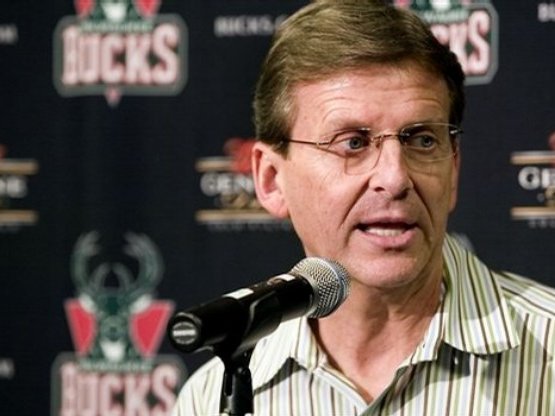As John Hammond leaned casually against the Bradley Center scorers' table during a media tournament Saturday, you could almost hear the gears grinding in his head.
By no means was he contemplating the less-than-impressive play of local writers and broadcasters, who were doing their best not to tear any ligaments or break any bones during a spirited morning of "basketball." Instead, Hammond had the look of a man with a plan.
In this case, it's a plan to get his Bucks back to relevance in the National Basketball Association.
Hammond has some work cut for him this summer. The Bucks have the 10th pick in the upcoming draft and the team is in the process of working out some of the college talent that may still be available when Milwaukee's turn comes. After that. He'll have to figure out what to do with Ramon Sessions and Charlie Villanueva, both of whom are restricted free agents.
With the Bucks teetering dangerously close to the NBA's salary cap and enjoying very little financial flexibility, the chances are good that Hammond will lose one or both of those players this summer. Just a qualifying offer to Villanueva, who finally came into his own last season, would cost roughly $4.6 million.
He'll have to try to figure out what to do with forward Richard Jefferson, who still has two years and just less than $30 million left on his contract. Teams have expressed interest, but Hammond doesn't want to gut the team, and Jefferson might be more valuable in a year when his $15 million salary comes of the books.
It's doubtful Hammond will find a buyer for Michael Redd's max contract, especially with the guard coming off season-ending surgery last year. Like Jefferson, he comes off the books in two seasons, but not after costing the franchise more than $35 million.
Dan Gadzuric? He's not going anywhere, either. The point is, there are a lot of reasons why Hammond and the Bucks could fall flat on their faces this coming season. But nothing about the man seems to suggest that's even a possibility. Between him and his hand-picked head coach, Scott Skiles, you get the impression that it's not even an option.
Hammond is a smart man. He learned the ropes under Pistons general manager Joe Dumars, who assembled a squad that brought four trips to the Eastern Conference Finals, two NBA Finals appearances and the 2005 NBA Championship.
It was Dumars' savvy that helped make that success possible; he spent money prudently, avoiding the max contracts that can doom franchises like the Bucks for years. He identified a core, and surrounded it with the right kind of role players and second-level talent that lends itself to long-term success, instead of a one-shot wonder.
It's not at all unlike the way Doug Melvin began rebuilding the Brewers back in 2002. Of course, Melvin had the good fortune of working with an emerging farm system -- an unavailable luxury in basketball -- but the similarities are there. In this case, Hammond isn't waiting for the basketball equivalent of J.J. Hardy, Ryan Braun and Prince Fielder; he's just trying to maintain interest and credibility with the fans until the finances improve to the point where the Bucks can be players again.
Like the Brewers in the early part of the decade, the Bucks have a long way to go in convincing fans to return to the Bradley Center. Hammond is fully aware that his team will more than likely not be playing come next June, but with a couple more victories, could become a playoff participant.
And that's just the first couple of steps. Hammond is a smart man. He's got a plan. And for the first time in a long time, its not out of the realm of possibility to think that the Bucks might actually become a contender again.







